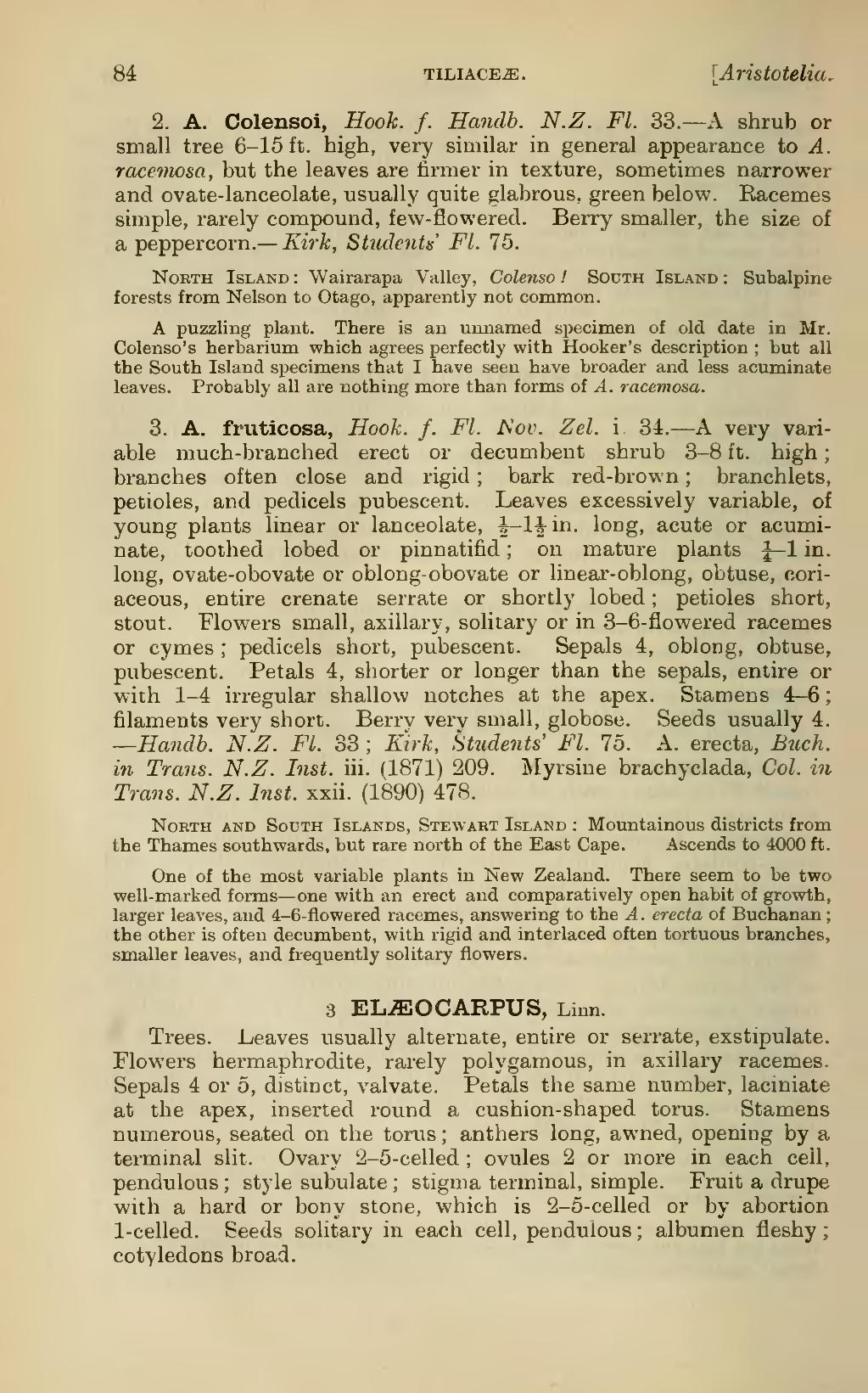2. A. Colensoi, Hook. f Handb. N.Z. Fl. 33.—A shrub or small tree 6–15 ft. high, very similar in general appearance to A. racemosa, but the leaves are firmer in texture, sometimes narrower and ovate-lanceolate, usually quite glabrous, green below. Racemes simple, rarely compound, few-flowered. Berry smaller, the size of a peppercorn.—Kirk, Students' Fl. 75.
North Island: Wairarapa Valley, Colenso! South Island: Subalpine forests from Nelson to Otago, apparently not common.
A puzzling plant. There is an unnamed specimen of old date in Mr. Colenso's herbarium which agrees perfectly with Hooker's description; but all the South Island specimens that I have seen have broader and less acuminate leaves. Probably all are nothing more than forms of A. racemosa.
3. A. fruticosa, Hook. f Fl. Nov. Zel. i, 34.—A very variable much-branched erect or decumbent shrub 3–8 ft. high; branches often close and rigid; bark red-brown; branchlets, petioles, and pedicels pubescent. Leaves excessively variable, of young plants linear or lanceolate, ½–1½ in. long, acute or acuminate, toothed lobed or pinnatifid; on mature plants ¼–1 in. long, ovate-obovate or oblong-obovate or linear-oblong, obtuse, coriaceous, entire crenate serrate or shortly lobed; petioles short, stout. Flowers small, axillary, solitary or in 3–6-flowered racemes or cymes; pedicels short, pubescent. Sepals 4, oblong, obtuse, pubescent. Petals 4, shorter or longer than the sepals, entire or with 1–4 irregular shallow notches at the apex. Stamens 4–6; filaments very short. Berry very small, globose. Seeds usually 4.—Handb. N.Z. Fl. 33; Kirk, Students' Fl. 75. A. erecta, Buch. in Trans. N.Z. Inst. iii. (1871) 209. Myrsine brachyclada. Col. in Trans. N.Z. Inst. xxii. (1890) 478.
North and South Islands, Stewart Island: Mountainous districts from the Thames southwards, but rare north of the East Cape. Ascends to 4000 ft.
One of the most variable plants in New Zealand. There seem to be two well-marked forms—one with an erect and comparatively open habit of growth, larger leaves, and 4–6-flowered racemes, answering to the A. erecta of Buchanan; the other is often decumbent, with rigid and interlaced often tortuous branches, smaller leaves, and frequently solitary flowers.
3. ELÆOCARPUS, Linn.
Trees. Leaves usually alternate, entire or serrate, exstipulate. Flowers hermaphrodite, rarely polygamous, in axillary racemes. Sepals 4 or 5, distinct, valvate. Petals the same number, laciniate at the apex, inserted round a cushion-shaped torus. Stamens numerous, seated on the torus; anthers long, awned, opening by a terminal slit. Ovary 2–5-celled; ovules 2 or more in each cell, pendulous; style subulate; stigma terminal, simple. Fruit a drupe with a hard or bony stone, which is 2–5-celled or by abortion 1-celled. Seeds solitary in each cell, pendulous; albumen fleshy; cotyledons broad.
